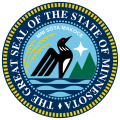The 1868 United States presidential election in Minnesota took place on November 3, 1868, as part of the 1868 United States presidential election . State voters chose four representatives, or electors, to the Electoral College , who voted for president and vice president . [ 1]
Minnesota was won by Ulysses S. Grant , formerly the 6th Commanding General of the United States Army (R -Illinois ), running with Speaker of the House Schuyler Colfax , with 60.88% of the popular vote, against the 18th governor of New York , Horatio Seymour (D –New York ), running with former Senator Francis Preston Blair Jr. , with 39.12% of the vote. [ 1]
This page is based on this
Wikipedia article Text is available under the
CC BY-SA 4.0 license; additional terms may apply.
Images, videos and audio are available under their respective licenses.




